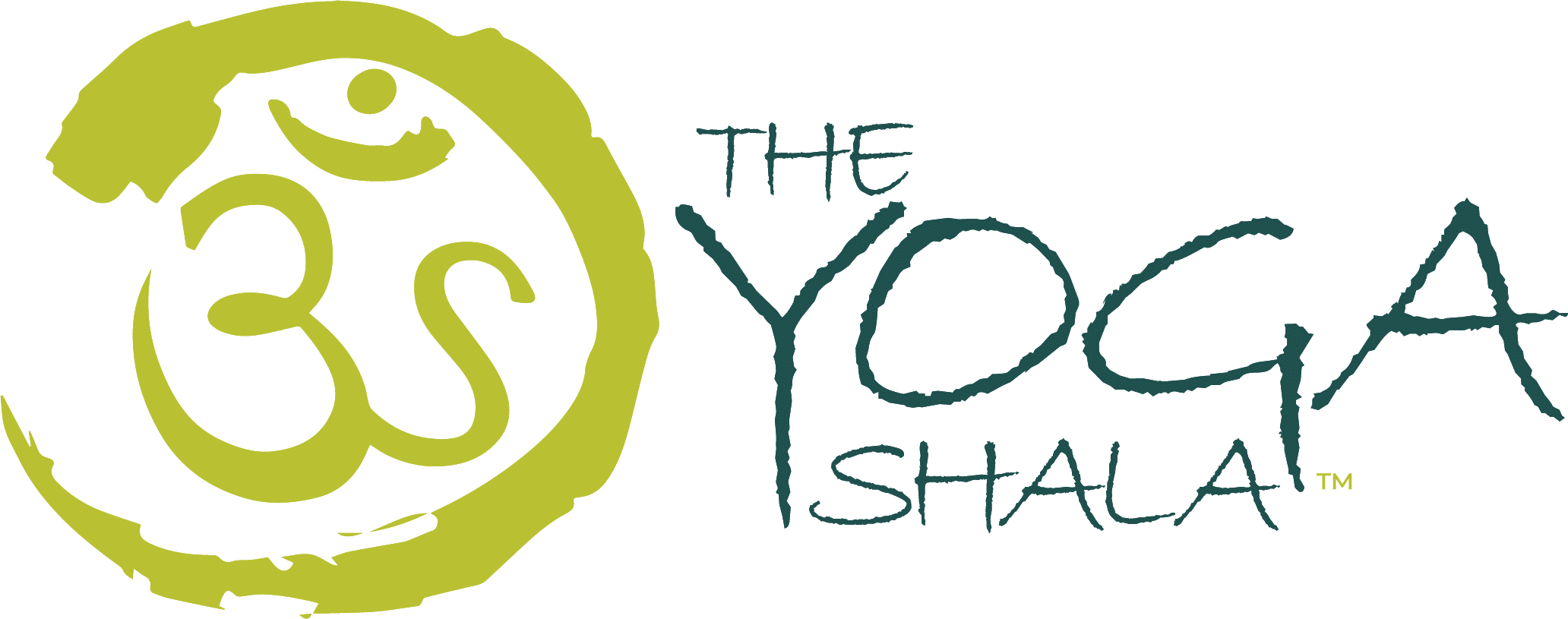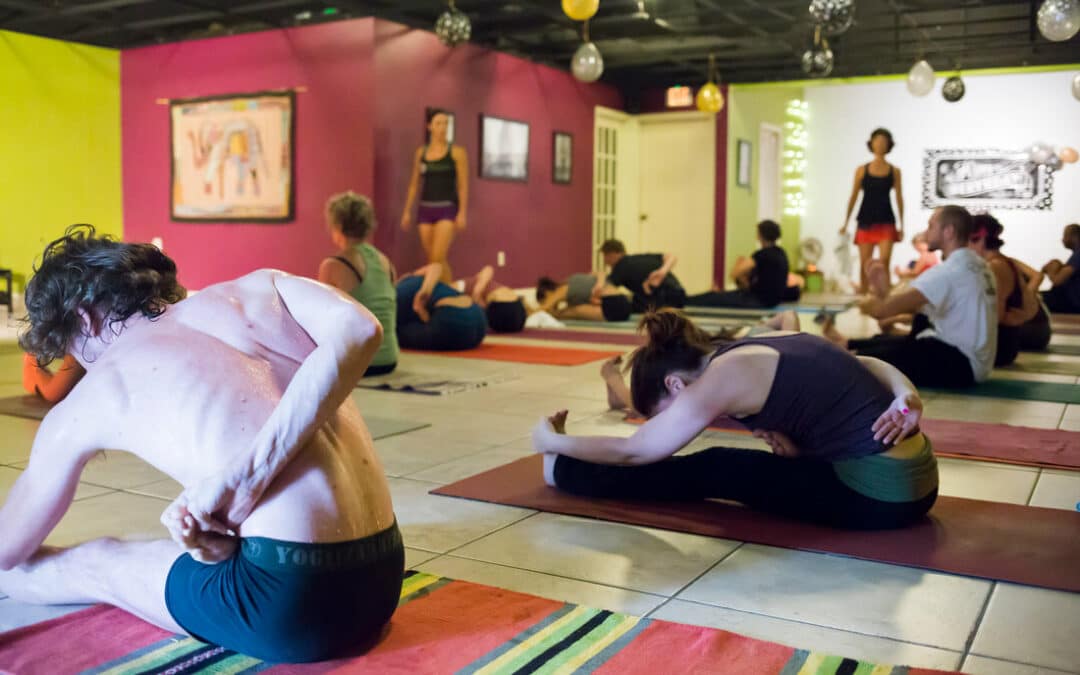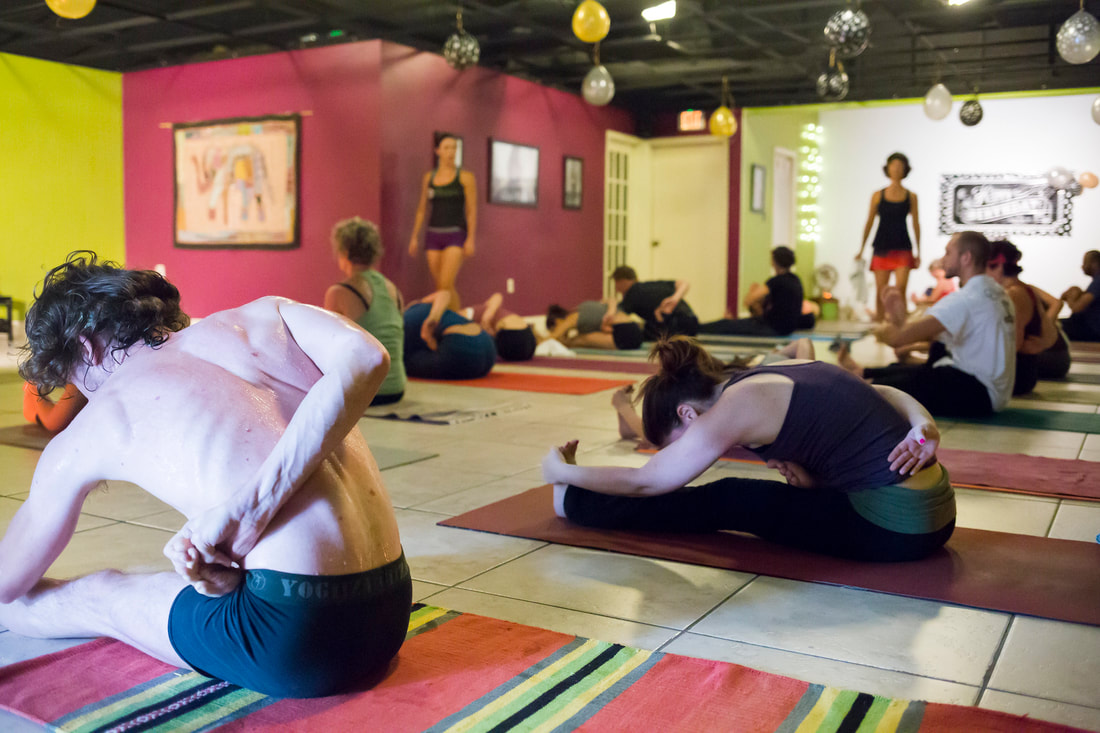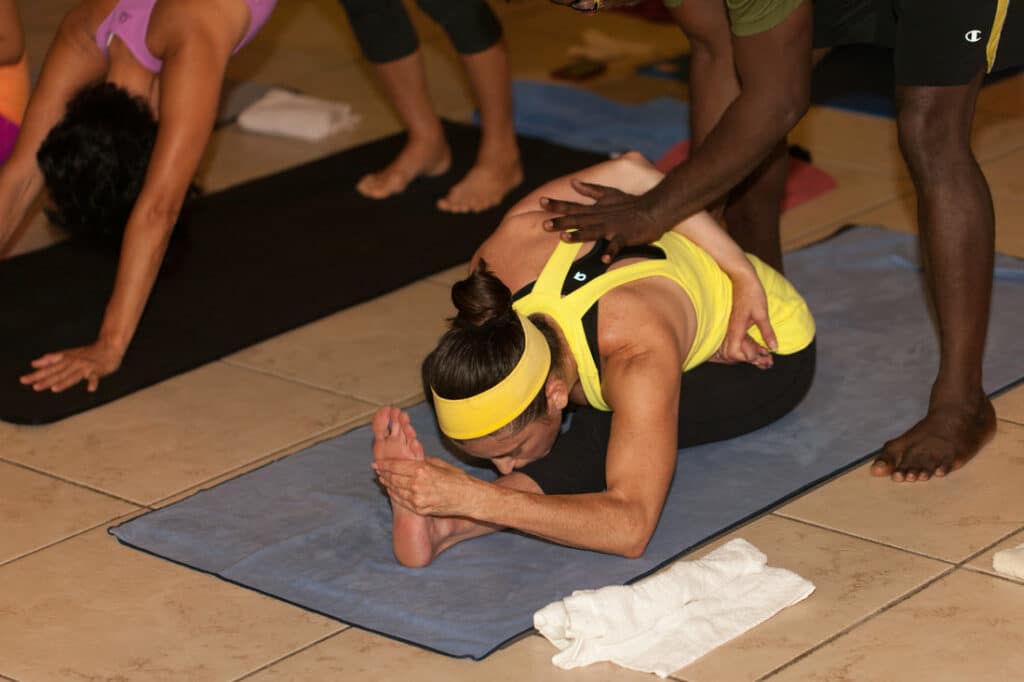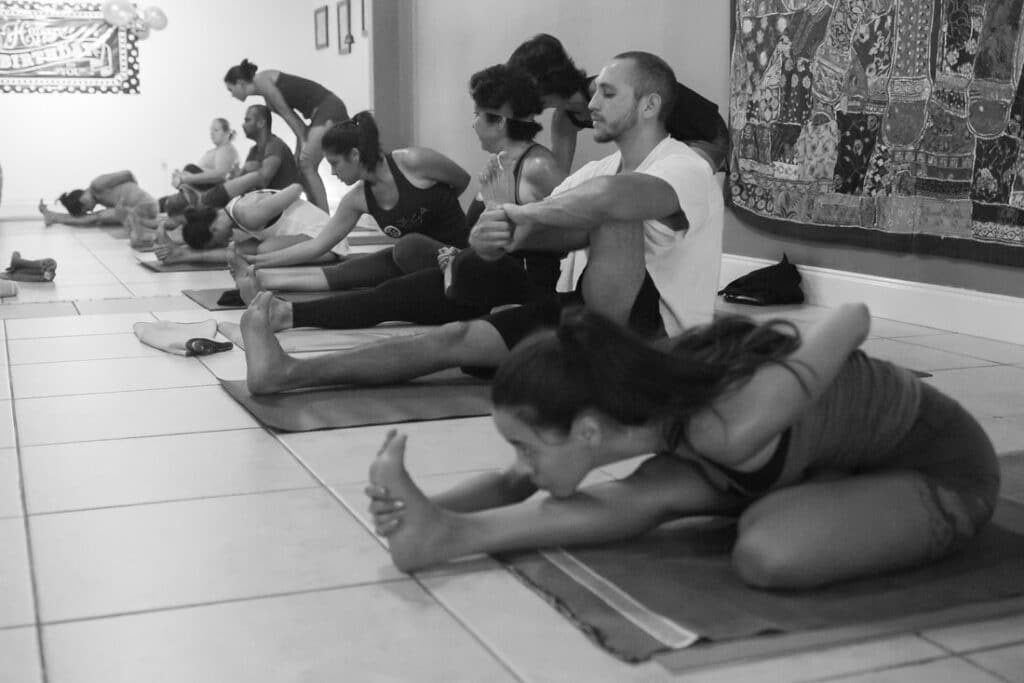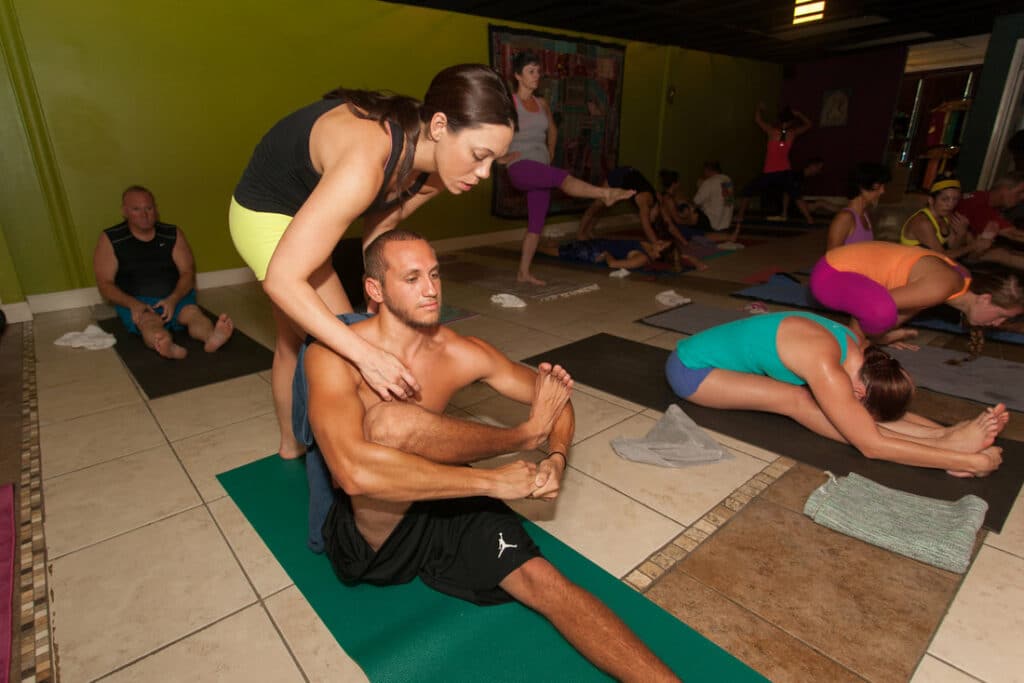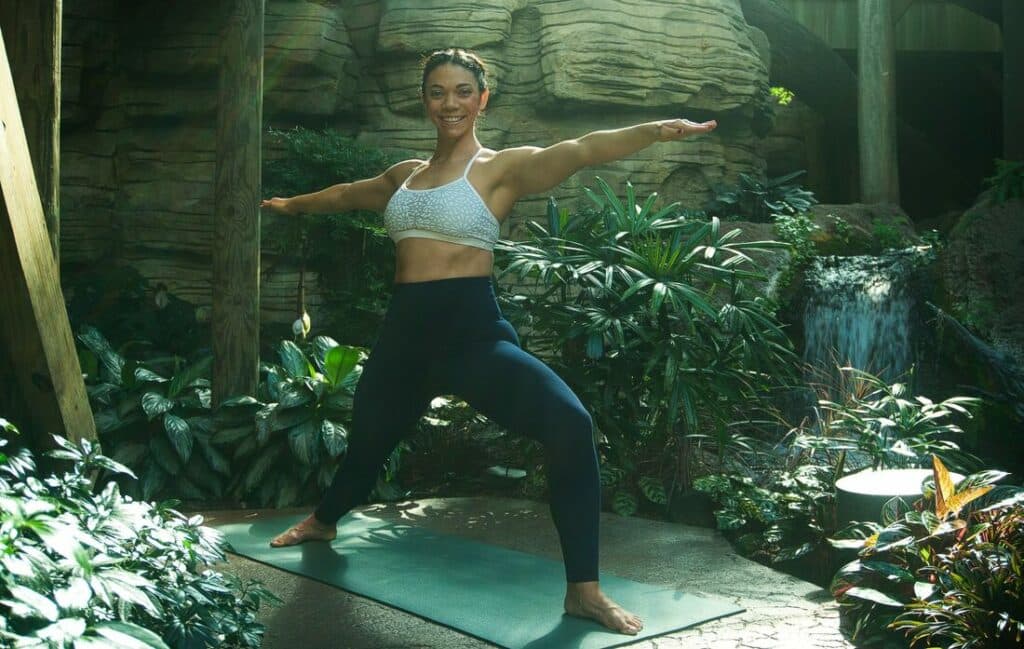Ashtanga Yoga is a traditional practice that follows a systematic sequence of postures, aiming to synchronize breath with movement. The first series in Ashtanga is known as the Primary Series or Yoga Chikitsa. In this blog post, we’ll explore primary series yoga posture, Ardha Baddha Padma Pascimottanasana.
Ardha Baddha Padma Pascimottanasana (half-bound lotus forward folding posture) is the fourth seated posture in the Ashtanga Yoga Primary Series. This pose is the first seated posture to incorporate a half-lotus and the first seated posture where we attempt to bind our hand to our foot. We will break down the full expression of this asana with correct vinyasa count.
Then we will explore some modifications/variations for Ardha Baddha Padma Pascimottanasana. Many students find they are unable to take the full expression the first time they attempt it. If this pose is challenging for you, please be patient with your body and work with modifications that will safely help you work up to the full expression over time. Remember that yoga is a journey, and regular practice combined with patience will help you deepen your practice over time.
Benefits of Ardha Baddha Padma Pascimottanasana
Improved Flexibility:
This pose stretches the hamstrings, hip flexors, and groins, gradually increasing flexibility in these areas.
Hip Opening:
The half-lotus position and the hip rotation involved in the pose help open up the hips, promoting mobility and alleviating tightness.
Strengthened Spine:
Ardha Baddha Padma Pascimottanasana encourages a lengthening of the spine, which strengthens the back muscles and improves posture.
Digestive Stimulation:
The forward fold compresses the abdominal organs, stimulating digestion and aiding in the detoxification process.
Calming the Mind:
The mindful breathing and deep stretching of this pose can have a calming effect on the nervous system, reducing stress and anxiety.
Energetic Alignment:
This pose encourages the flow of energy (prana) through the body, promoting balance and vitality.
Click here to watch the YouTube tutorial for Ardha Baddha Padma Paschimottanasana
Contraindications
While Ardha Baddha Padma Paschimottanasana offers numerous benefits, there are certain conditions and situations in which this pose should be avoided or practiced with caution:
Knee or Hip Injuries:
If you have any knee or hip injuries or discomfort, especially in the knee of the bent leg, avoid or modify the pose. Ensure that the leg is comfortable in the half-lotus position without straining the joints. See modifications below.
Sciatica:
Individuals with sciatica may find this pose aggravating. Consult with a yoga instructor or healthcare professional before attempting it.
Pregnancy:
Pregnant individuals should avoid deep forward bends, as they can put pressure on the abdomen and disrupt blood flow to the uterus. It’s recommended to practice a modified version or skip this pose during pregnancy. See modifications below.
High Blood Pressure:
People with uncontrolled high blood pressure should practice with caution, as the forward fold may lead to a sudden increase in blood pressure. Keep the forward bend shallow.
Lower Back Issues:
If you have lower back issues, practice with caution and start with modifications listed below.
Ankle or Foot Injuries:
If you have ankle or foot injuries, avoid placing your foot on the thigh of the opposite leg. Instead, practice one of the variations of this pose.
Always prioritize your body’s comfort and safety in any yoga practice. If you have any medical conditions or concerns, it’s advisable to consult a healthcare professional or a qualified yoga instructor before attempting new poses. They can provide personalized guidance and modifications to ensure that your practice is safe and beneficial.
Step-by-Step Instructions for practicing Ardha Baddha Padma Paschimottanasana (with Vinyasa Count)
We will be entering this posture from downward facing dog, having just taken a vinyasa after Purvottanasana to seated position.
Sapta (Vinyasa #7): From Adho Mukha Svanasana (down dog), look forward and walk or jump your feet through and have a seat on the floor with your legs extended in front of you. Inhale, bend your right knee and bring your right heel toward your perineum (the space between your anus and genitals). This is the half-lotus position. On the same inhale, take your right arm behind you and around your body and clasp the big toe of your right foot with your right thumb, index and middle finger.
Asthau (Vinyasa #8) Exhale and fold forward out over your straight left leg. Grab your left foot with your left hand. Be sure you maintain flexion in your left foot, engage the left quadricep and press your heel forward as you press your tailbone backward. Bring your chin to your chin if you can. Look towards your toes (Padhayoragrai drishti). Breathe here for five deep breaths. With each inhale, elongate your spine, lifting your chest slightly.
Adjustments and Alignment Tips:
- Keep both sitting bones grounded to maintain balance.
- Flex your left foot actively to engage the muscles and protect the knee.
- Lengthen your spine on each inhale and deepen the stretch on each exhale.
Breathing:
- The vinyasa count guides your breath. Inhale during the lengthening phases and exhale during the folding phases.
- Maintain deep breathing with sound —a deep, audible breath—throughout the pose to help you stay focused and relaxed.
Nava (Vinyasa #9) Inhale, lift your head and lengthen your spine. Keeping your left hand to your left foot and right hand to your right foot. Exhale there.
Dasa (Vinyasa #10) Inhale, bring your hands to the floor, cross your legs and lift your body up off the ground.
Ekadasa (Vinyasa #11) Exhale and jump back into Chaturanga Dandasana.
Dvadasa (Vinyasa #12) Inhale into Urdhva Mukha Svanasana(Upward facing dog)
Trayodasa (Vinyasa #13) Exhale into Adho Mukha Svanasana (Downward facing dog)
Caturdasa (Vinyasa #14) From Adho Mukha Svanasana (down dog), look forward and walk or jump your feet through and have a seat on the floor with your legs extended in front of you. Inhale, bend your left knee and bring your left heel toward your perineum (the space between your anus and genitals). This is the half-lotus position. On the same inhale, take your left arm behind you and around your body and clasp the big toe of your right foot with your right thumb, index and middle finger.
Pancadasa (Vinyasa #15) Exhale and fold forward out over your straight right leg. Grab your right foot with your right hand. Be sure you maintain flexion in your left foot, engage the left quadricep and press your heel forward as you press your tailbone backward. Bring your chin to your chin if you can. Look towards your toes (Padhayoragrai drishti). Breathe here for five deep breaths. With each inhale, elongate your spine, lifting your chest slightly.
Sodasa (Vinyasa #16) Inhale, lift your head and lengthen your spine. Keeping your left hand to your left foot and right hand to your right foot. Exhale there.
Saptadasa (Vinyasa #17) Inhale, bring your hands to the floor, cross your legs and lift your body up off the ground.
Ashtadasa (Vinyasa #18) Exhale and jump back into Chaturanga Dandasana.
Ekoonavimsatih (Vinyasa #19) Inhale into Urdhva Mukha Svanasana(Upward facing dog)
Vimsatih (Vinyasa #20) Exhale into Adho Mukha Svanasana (Downward facing dog)
Click here to watch the YouTube tutorial for Ardha Baddha Padma Paschimottanasana
Modifciations
Modifications are essential to ensure that yoga poses are accessible and safe for practitioners of all levels and abilities. Here are some modifications for Ardha Baddha Padma Pascimottanasana:
Modification One (1):
Start with both legs straight out on the floor in front of you. Inhale and lift your right leg up, internally rotate the right leg from knee to foot and grab the right knee with the right hand. Place the left hand on the right foot. Breathe here five deep breaths. Work to lift out of your sits bones and extend your spine up. At the same time, strongly grip your hands to your knee and foot and pull your elbows back to help you engage your back. After five deep breaths, switch sides.
Modification Two (2):
Click here to watch the YouTube tutorial for Ardha Baddha Padma Paschimottanasana
Start with both legs straight out in front of you. Inhale and lift your right leg up, internally rotate the right leg from knee to foot and wrap your arms around your right leg. If you can, interlace your fingers/hands together. Flex both feet and work to press your right foot into your left arm. Simultaneously work to press your left arm into our right foot. Sit up tall. Breathe here five deep breaths. Work to lift out of your sits bones and extend your spine up. Work to activate your mid back by gently squeezing your shoulder blades together. After five deep breaths, switch sides.
Modification Three (3):
Start with both legs straight out in front of you. Inhale and work to bring your right foot into half-lotus position (bring your right foot on top of your left thigh, toes pointing towards your hip). Grip your right foot with your left hand and gently pull the foot back toward your hip. Bend your left elbow and engage your back. Extend your right arm out in front of you, thumb up. As you exhale start to take your right arm back behind you, but keep your arm extended here. You are working to open your line of fascia in your pectoralis area. Sit up tall. Take five deep breaths here. With each inhale work to sit taller. With each exhale work to take your right arm further back, deepening the stretch in your chest. After five deep breaths, switch sides.
Ardha Baddha Padma Pascimottanasana offers an opportunity to cultivate focus, flexibility, and mindfulness. By following the step-by-step guide and vinyasa count, you can confidently integrate this pose into your Ashtanga Yoga practice. Remember that yoga is a journey. Enjoy your practice!
Practice with The Yoga Shala
If you want to join us for LIVE classes! The Yoga Shala offers virtual and in person classes every weekday morning. We are located at 140 Circle Drive, #4, Maitland, Florida. Owner, Krista Shirley, also offers virtual or in person private sessions (Yoga, Meditation, Breath-work, Nutrition, Life Coaching and Mentorship). Visit theyogashala.com for details.
Be sure to signup for our newsletter to stay on top of local events and classes, Nysa products sales, new offerings, new products and more!
We hope you find this video series helpful to you in creating or maintaining your yoga practice!
About Krista
Krista Shirley is a level II authorized Ashtanga Yoga teacher. She is deeply passionate about sharing these teachings with all who wish to learn.
If you want to join Krista in person she teaches daily classes at The Yoga Shala in Maitland, Florida. She also offers virtual sessions in Yoga, Meditation, Breath-work, Nutrition, Life Coaching and Mentorship. Check out www.theyogashala.com for more details.
If you do not live in Central Florida and want to find an authorized teacher in your area, check out our teacher, Sharath Jois’ website, for a list of all teachers authorized and certified by his yoga centre in India.
|
|
|
|
|
|
|
|
|
|
|
|
❤️SHOP MERCHANDISE: Nysa Products
❤️LET’S BE SOCIAL:
Instagram: Krista Shirley Yoga
Instagram: The Yoga Shala
Facebook: The Yoga Shala
Facebook: KristaShirleyYoga
For other inquires please contact: [email protected]
